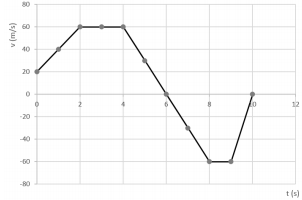Questões de Concurso
Comentadas para fundep (gestão de concursos)
Foram encontradas 14.313 questões
Resolva questões gratuitamente!
Junte-se a mais de 4 milhões de concurseiros!

GOULART,E. et.al. Ocultas minas no sertão das gerais. Belo Horizonte: Coopmed, 2014, p. 92.
When the narrator of the text says that the doctor had advised against the stairs, the understanding is that
Um objeto se move segundo o gráfico velocidade X tempo descrito a seguir.

De acordo com o gráfico é correto afirmar que esse objeto desenvolveu um movimento

De acordo com o diagrama, é correto afirmar que durante o processo
COLUNA II ( ) “A solidariedade social é forte, inclina fortemente os homens entre si, coloca-os em frequente contato, multiplica as ocasiões que têm de se relacionarem. [...] Quanto mais solidários são os membros de uma sociedade, mais relações diversas sustentam, seja entre si, seja com o grupo tomado coletivamente, porque se os seus encontros fossem raros eles não dependeriam uns dos outros, senão de maneira frágil e intermitente”. (Quintaneiro, 2002, p. 81) ( ) “As camadas mais baixas do proletariado – as mais instáveis do ponto de vista econômico, de muito difícil aceso às concepções racionais – e as camadas da pequena burguesia – em decadência proletária ou em constante indigência e ameaçadas de proletarização – são presa fácil de missões religiosas, sobretudo as que adquirem forma mágica ou mágico-orgiástica [...] Sem dúvida é mais fácil que prosperem sobre esse solo os elementos emotivos do que os racionais de uma ética religiosa”. (Quintaneiro, 2002, p. 133) ( ) “Um primeiro pressuposto de toda existência humana e, portanto, de toda história [...] (é) que os homens devem estar em condições de poder viver a fim de “fazer história”. Mas, para viver, é necessário, antes de mais nada, beber, comer, ter um teto onde se abrigar, vestir-se etc. o primeiro fato histórico é, pois, a produção dos meios que permitem satisfazer essas necessidades, a produção da própria vida material; trata-se de um fato histórico; de uma condição fundamental de toda a história, que é necessário, tanto hoje como há milhares de anos, executar, dia a dia, hora a hora, a fim de manter os homens vivos”. (Quintaneiro, 2002, p. 32)
Assinale a sequência correta.
I. Uma das características mais distintivas do sistema econômico das sociedades modernas é a existência de uma divisão do trabalho extremamente complexa: o trabalho passou a ser dividido em um número enorme de ocupações diferentes nas quais as pessoas se especializam. II. As mulheres que trabalham fora historicamente se concentraram em ocupações mal remuneradas, que envolvem atividades de rotina. Muitos desses empregos são extremamente marcados pelo gênero. Apesar da igualdade formal em relação aos homens, as mulheres ainda passam por diversas situações de desigualdade no mercado de trabalho. III. Há quem fale na “morte das carreiras” e no advento do trabalhador de portfólio – aquele que possui e apresenta diferentes habilidades, afirmando que tem condições de se deslocar prontamente de um emprego para outro. Assim, por qualquer ângulo que seja observada, a flexibilização do trabalho é considerada uma prática benéfica à sociedade.
Estão corretas as afirmativas